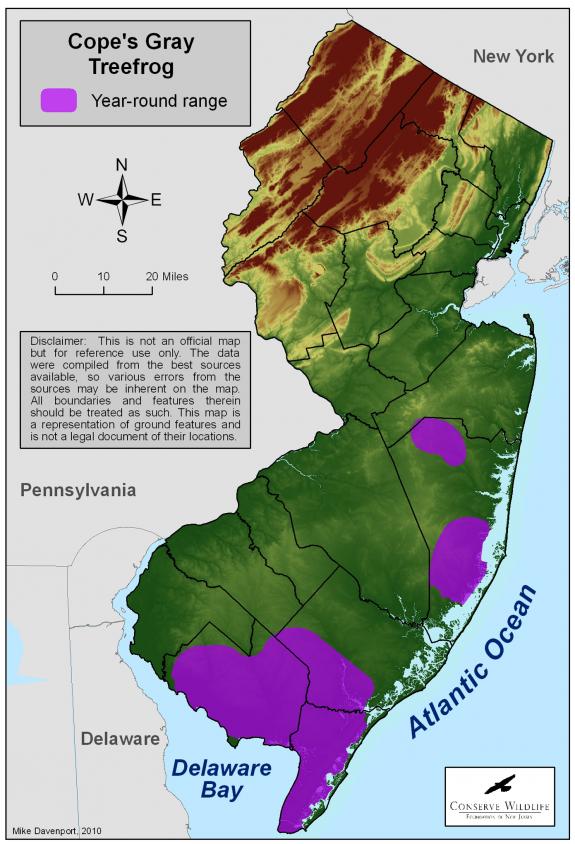Dryophytes chrysoscelis
Type: amphibian
Status: threatened
Species Guide
Cope's gray treefrog
Dryophytes chrysoscelis
Species Type: amphibian
Conservation Status: threatened
Identification
Also sometimes known as Southern gray treefrog. Ground color in the adult is gray; however, green or brown frogs may be seen, and individual frogs may show variations in color depending on conditions. There is usually a white or yellow spot below each eye. The inner surface of the hind legs is yellow or orange, sometimes with black speckling. The upper body is dark and warty. Toe pads are large and rounded. Males have a dark throat, while females have a white throat. Juvenile frogs are often bright green. Tadpoles are easily recognizable, with reddish tails and olive bodies. Adults are 1.25 to 2” in length.
These frogs are nearly identical in appearance to the northern gray treefrog. They can only be told apart by their calls or chromosomal analysis. The call of the southern gray, a resounding trill, is faster and higher pitched than that of the northern gray treefrog.

Distribution & Habitat
In New Jersey, the southern gray treefrog is limited to Cape May, Cumberland, Atlantic, and Ocean counties. Within this area, most populations are located in southern Cape May County.
Southern gray treefrogs spend most of their time high in the trees, except during breeding season when move to the water’s edge. Bare horizontal branches over water are the preferred calling sites during breeding season. They breed in vernal ponds or swamps, and remain in mixed forested uplands during the rest of the year. Like many treefrogs, these species frequently call on warm rainy days outside of breeding season.
Southern gray treefrogs rely on small freshwater ponds, old fields, and hardwood forests throughout their annual cycle. They breed in a wide variety of natural and man-made basins. Breeding pools must contain water long enough to ensure metamorphosis but dry up by the end of summer, in order to prohibit the establishment of predatory fish. Breeding ponds are located within or near deciduous or mixed woodlands such as climax oak/pine forests.
Diet
Southern gray treefrogs rest during the day and forage at night. They feed on flying insects as well as those found hidden amid branches and leaves. Flies, mosquitoes, gnats, spiders, and ants, in addition to other insects and insect larvae, are included in the diet. The tadpoles feed on algae within their natal ponds.
Life Cycle
In late April and early May, nighttime temperatures exceeding 63°F stimulate the vocal activity of southern gray treefrogs. Although they may call from late April to mid-August, choruses peak during warm, humid evenings in May or June. Males may vocalize from trees, shrubs, or the ground to attract females to breeding ponds.
The female deposits individual eggs or groups of up to 40 eggs on aquatic vegetation and leaf litter within a breeding pond. The egg masses are then fertilized by the male. The female will have laid a total of nearly 2,000 eggs in a season. By laying eggs singly or in small clumps, the female reduces the likelihood of losing an entire clutch to predation or desiccation. The eggs hatch in four to five days and metamorphosis occurs in 80 to 100 days. Following emergence, the young frogs disperse into nearby fields and forests.
During July and August, adult treefrogs migrate to terrestrial habitats surrounding their breeding ponds. Here, they dwell in tree cavities, underneath bark, or inside underground burrows, where they will remain over the winter. Gray treefrogs are able to withstand freezing and thawing due to an “antifreeze” present in their blood.
Current Threats, Status, and Conservation
Over the past 20 years, biologists have conducted research to determine the natural history and breeding ecology of the southern gray treefrog in New Jersey. Currently, efforts are being made to protect treefrog habitats on a landscape level as well as on an individual wetland basis. Documented breeding ponds, as well as surrounding buffers of 150 to 300 feet, are protected under New Jersey land use regulations.
The destruction of both forests and woodland ponds threatens southern gray treefrog populations in New Jersey. Small vernal ponds are vulnerable to illegal filling. Although current land-use regulations protect wetlands, many upland habitats remain vulnerable. Treefrogs require both wetlands and adjacent forested uplands for their life cycle. Habitat loss is often coupled with degradation of water quality, as runoff, wastewater effluent, leaching of toxic chemicals, and illegal dumping all pollute ponds.
Predation of treefrog eggs and larvae within breeding ponds may limit populations. Mosquito fish, which are released into ponds to control mosquitoes, are also feed on treefrog eggs and larvae.
The southern gray treefrog has the ability and long-term necessity to move between breeding ponds and colonize suitable new ponds within the same wetland complex. Thus, management for viable, sustained populations must include the protection of wetland areas surrounding occupied ponds in order to provide additional habitat and to maintain genetic diversity.
In suitable habitat where southern gray treefrogs occur, artificial ponds can be excavated to provide additional breeding habitat. Although artificial ponds may provide supplemental habitat, they should not be seen as a substitute for existing natural ponds. Habitat protection must be the highest priority.
In 2016, the New Jersey Endangered and Nongame Advisory Committee recommended changing this species status from Endangered to Threatened within the state. In January 2025, the rule proposal for upgrading the species status was finally adopted.
, but no formal rule proposal has been filed to date.
References
Text derived from the book, Endangered and Threatened Wildlife of New Jersey. 2003. Originally written by Sherry Liguori. Edited and updated by Brian Henderson & Mike Davenport in 2016.
Scientific Classification
- Kingdom: Animalia
- Phylum: Chordata
- Class: Amphibia
- Order: Anura
- Family: Hylidae
- Genus: Dryophytes
- Species: D. chrysoscelis